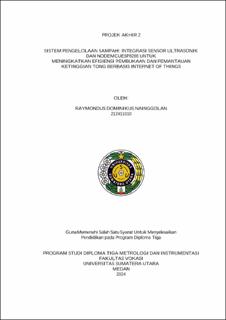Sistem Pengelolaan Sampah: Integrasi Sensor Ultrasonik dan Nodemcuesp8266 untuk Meningkatkan Efisiensi Pembukaan dan Pemantauan Ketinggian Tong Berbasis Internet of Things
Waste Management System: Integration of Ultrasonic Sensors and Nodemcu ESP8266 to Enhance Bin Opening and Level Monitoring Efficiency Based on Internet of Things

Date
2024Author
Nainggolan, Raymondus Dominikus
Advisor(s)
Maghfirah, Awan
Metadata
Show full item recordAbstract
It has been designed an Internet of Things (IoT)-based waste management device aimed at enhancing efficiency and practicality in waste management. This device utilizes the HC-SR04 ultrasonic sensor and NodeMCU ESP8266 microcontroller to create an automated trash bin. This research employs a comparative methodology, involving tests for sensor accuracy and effectiveness, alongside validation of notifications through the Telegram application. The test results demonstrate that the HC-SR04 ultrasonic sensor exhibits remarkably high accuracy in measuring the height of solid objects, with an average error rate below 1%, thereby achieving 99% accuracy or higher. In the initial test, the sensor accurately measured the height of a plastic cup with an error percentage of 0.013%, indicating 99.987% accuracy. Subsequent tests with a digital scale prototype and a glass bowl yielded error percentages of 0.1% and 0.11%, respectively, affirming accuracies of 99.9% and 99.89%. Tests involving a wooden carving and a wallet resulted in error percentages of 0.08% and 0.35%, corresponding to accuracies of 99.92% and 99.65%. Overall, these evaluations establish the HC-SR04 ultrasonic sensor as highly effective and precise in measuring the height of solid objects with minimal error. Furthermore, the system effectively sends accurate notifications via Telegram, enabling real-time monitoring of the trash bin's fill level and timely alerts when it reaches capacity. This capability enhances waste management efficiency by ensuring timely trash disposal. In conclusion, this study underscores the potential of the developed IoT-based waste management system to improve waste management practices and promote environmental cleanliness. The implementation of this system not only addresses local sanitation challenges but also serves as a scalable solution for broader adoption.
Collections
- Diploma Papers [158]
